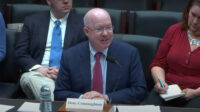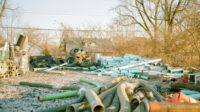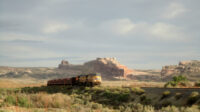EPA Touts Record Wildfire Cleanup Progress as Communities Push Back on Toxic Waste Sites
As Phase 1 hazardous material removal nears completion, the Army Corps of Engineers is ramping up Phase 2 operations

Army's airborne sensors support debris removal after LA's historic wildfires.
Source: Maj. Spencer Garrison
The Environmental Protection Agency announced on Monday that it has completed 75% of its hazardous waste removal mission in Los Angeles County's devastating wildfire zones, just as the U.S. Army Corps of Engineers launches an ambitious second phase of debris removal that could take up to a year to complete.
"EPA staff on the ground are working around the clock to get as many properties cleared of hazardous material as quickly and safely as possible," EPA Administrator Lee Zeldin said in a statement, calling it the largest wildfire cleanup in the agency's history.
The massive operation, launched January 28, involves clearing hazardous materials from nearly 14,000 properties damaged in the Eaton and Palisades fires. More than 1,600 personnel have been deployed across 121 specialized teams, including dedicated units for handling dangerous lithium-ion batteries from damaged electric vehicles and home energy systems.
"This mission is personal for us," said Maj. Gen. Jason Kelly, USACE deputy commanding general for Civil and Emergency Operations. "Our teams on the ground are bringing the same urgency, precision and care to residential properties that we do with all our civil works and military construction missions around the world."
But a Los Angeles Times investigation revealed this week that millions of tons of potentially contaminated ash and rubble are headed for Southern California landfills that weren't designed to handle high concentrations of toxic chemicals. At least seven nonhazardous waste landfills are preparing to accept the debris, including facilities in Simi Valley, Sylmar, and Agoura.
The revelation has intensified opposition from communities near both temporary processing sites and final disposal locations. In Duarte, about a mile from one of four federal staging areas, real estate agent Catalina Pasillas told The New York Times that smoke from the fires had already exacerbated her asthma. Now she worries the waste site at Lario Park will further poison the air.
"I understand they need to put the toxic waste somewhere," Pasillas said. "But it feels like they chose our city because they thought we wouldn't say anything."
That sentiment echoed through a recent town hall meeting where hundreds of residents confronted EPA and state officials. The mayors of four nearby cities questioned whether their predominantly working-class Black and Hispanic neighborhoods were being unfairly targeted.
"We are a poor Latino community," Azusa Mayor Robert Gonzales said. "Are we looked at with a different set of glasses, compared to Palisades or Pasadena? In cleaning up one crisis, are we manufacturing a second one?"
The scope of the waste challenge is staggering. Previous state assessments of wildfire ash, according to the LA Times, have found levels of heavy metals – including brain-damaging lead – that would typically classify as hazardous waste under California standards. Yet through emergency waivers and disaster exemptions, this material can be treated as nonhazardous waste.
At the Sunshine Canyon Landfill in Sylmar, L.A. County's largest active disposal site, resident Erick Fefferman worries about toxic ash becoming airborne. The facility was cited over 60 times last year for excessive air pollution and nuisance odor violations.
"Sunshine Canyon Landfill has shown itself incapable of processing the household waste that already goes to their facility," Fefferman told the LA Times. "Adding toxic debris from a wildfire with known heavy metals and contaminants defies all common sense. Let's not compound one disaster and create another one."
EPA officials insist their operation follows strict safety protocols. At the Lario Park staging site, workers in protective gear carefully sort materials under illuminated tents, using specialized containers for different types of waste. Lithium-ion batteries are de-energized in salt-and-bicarbonate solution baths before transport.
"I've been doing this for over 15 years in California, Hawaii and other places," Steve Calanog, the EPA's deputy incident commander, told the New York Times. "We've never had a problem."
As Phase 1 hazardous material removal nears completion, the Army Corps of Engineers is ramping up Phase 2 operations. Col. Eric Swenson, commander of the USACE Recovery Field Office, said his agency is "committed to helping residents in communities across LA County rebuild." While the Corps estimates most properties will be cleared within a year, they expect to complete many sites well before that deadline.
The compressed timeline for the initial hazardous waste removal – shortened to 30 days by presidential order – has amplified fears about proper procedures being followed. While Governor Gavin Newsom praised the "unprecedented, record-breaking speed" during a visit to Altadena Tuesday, some see the pace itself as cause for concern.
"What happens when they skip over or miss a lithium-ion battery, from a cellphone battery, or part of a car battery — and it gets in there — and then combusts?" Fefferman asked, pointing to an underground fire already burning at another local landfill.
The situation highlights growing challenges as climate change drives more frequent and destructive wildfires. Similar disposal conflicts emerged after California's 2018 Camp Fire and the 2023 Maui fires, where a temporary debris landfill south of Lahaina still hasn't been relocated to a permanent site.
Los Angeles County officials warn residents to expect increased truck traffic in affected neighborhoods and along debris removal routes to local landfills as Phase 2 operations accelerate. Meanwhile, the EPA maintains it will complete its hazardous waste removal within the 30-day timeline, allowing reconstruction to begin by early April. But for communities near disposal sites, the cleanup's legacy may linger far longer.
"We feel for those people," said Wayde Hunter, president of the North Valley Coalition of Concerned Citizens, referring to wildfire victims. "But, by the same token, [cleanup and disposal] needs to be done properly. We can't just start dumping this stuff at every landfill."




